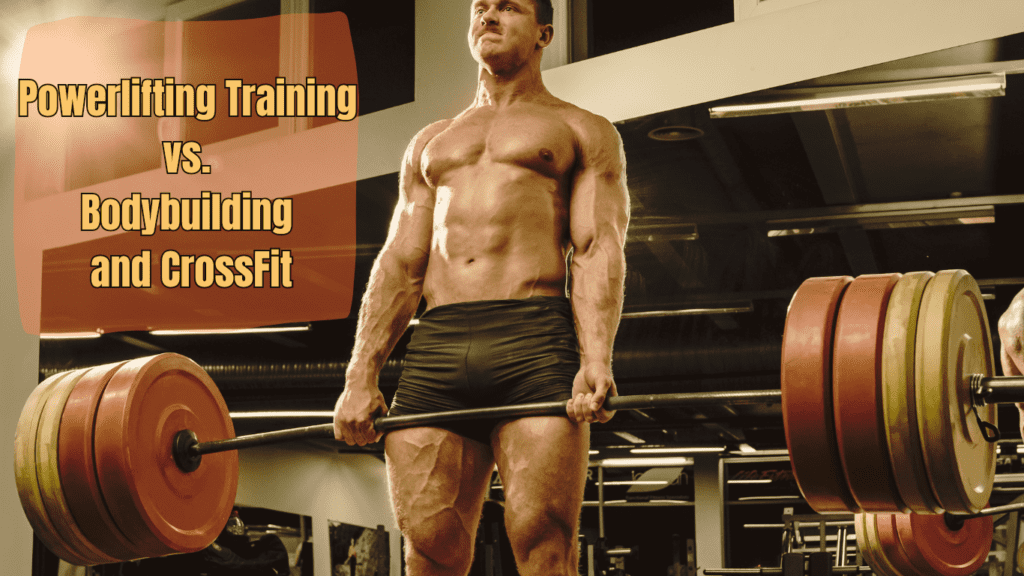Why Upper Body Calisthenics Exercises Are Essential for Strength and Endurance
In this article, we’ll explore how upper body calisthenics exercises can help you build impressive strength, enhance endurance, and achieve your fitness goals—all with just your body weight.
Did you know that the ancient Greeks were some of the first people to embrace bodyweight training? They didn’t have gym memberships, but they did have rock-solid abs! This intriguing fact highlights a practice that has been effective for centuries: calisthenics. In this article, we’re focusing on upper body calisthenics exercises, a form of workout that continues to deliver impressive results.
Our goal is to provide a comprehensive look at upper body calisthenics exercises. We will explore what these exercises entail, how they function, and why they are essential for a balanced fitness routine. This guide will offer practical advice, delve into the science behind these movements, and help you integrate them into your workouts effectively. We aim to present this information in a way that is both informative and engaging.

The significance of upper body calisthenics exercises lies in their ability to enhance strength, endurance, and overall functionality. These movements utilize your body weight as resistance, engaging multiple muscle groups simultaneously. This comprehensive approach helps in developing balanced muscle strength and improving overall physical fitness.
In addition to building strength, these exercises are excellent for increasing endurance. Regular practice of these bodyweight movements allows your muscles to adapt, enabling you to sustain effort for longer periods. This boost in stamina benefits not only your workouts but also enhances performance in everyday activities, from sports to daily tasks.
Subscribe And Get Our Free E-Book:Unlocking The Power Of Nutrition-Supplements, Substitutes, and Superfoods!
Furthermore, incorporating bodyweight exercises into your routine improves overall functionality. Unlike traditional gym machines that isolate specific muscles, calisthenics movements encourage natural, functional patterns. This means that the strength and endurance gained from these exercises directly translate into better performance in real-life scenarios.
Upper body calisthenics exercises are a valuable addition to any fitness regimen. They offer numerous benefits, including increased strength, improved endurance, and enhanced functionality. By understanding and implementing these exercises, you can achieve a well-rounded workout that supports overall health and performance.
15 Min Calisthenics Upper Body Workout Video
What is Calisthenics?
Have you ever wondered why calisthenics exercises seem to defy gravity? Maybe it’s because they don’t rely on fancy equipment or complicated routines—they just get you moving! Calisthenics, in its essence, is all about using your own body weight to build strength and flexibility. Let’s break down what calisthenics is, especially focusing on upper body calisthenics exercises, and why it’s a valuable addition to your fitness routine.

Calisthenics refers to a form of exercise that relies on bodyweight movements rather than external weights or machines. The term itself is derived from the Greek words “kallos,” meaning beauty, and “sthenos,” meaning strength. This highlights the idea that these exercises are designed to enhance both physical strength and overall aesthetics. Historically, calisthenics has been around since ancient times, with the Greeks being among the first to practice bodyweight training. Over the centuries, it has evolved from basic movements like push-ups and pull-ups to a more structured and varied form of training.
When we talk about upper body calisthenics exercises, we’re referring to exercises specifically targeting the muscles in the upper half of the body—think arms, shoulders, chest, and back. These exercises are renowned for their effectiveness in enhancing muscle growth, improving joint stability, and promoting better posture.
Muscle Growth is one of the most notable benefits of upper body calisthenics exercises. Unlike traditional weightlifting, which often isolates muscles, calisthenics involves movements that engage multiple muscle groups simultaneously. For example, a push-up doesn’t just work your chest; it also involves your shoulders, triceps, and core. This multi-muscle engagement helps in developing a balanced and functional upper body strength.
Joint Stability is another crucial benefit of upper body calisthenics exercises. Since these exercises require you to support and control your body weight through various movements, they help in strengthening the muscles around your joints. This leads to improved stability and reduced risk of injuries. For instance, exercises like pull-ups and dips enhance the strength and stability of your shoulder joints, which can be particularly beneficial if you participate in other sports or activities that put stress on these areas.
Improved Posture is also a significant advantage of incorporating upper body calisthenics exercises into your routine. Many calisthenics movements, such as planks and push-ups, require you to maintain a straight and aligned posture throughout the exercise. Regular practice helps in strengthening the muscles that support proper posture, reducing the likelihood of back and neck pain caused by poor alignment.
To understand how upper body calisthenics exercises work, it’s essential to delve into the science behind bodyweight training. At its core, calisthenics involves the principle of muscle engagement and progressive overload. When you perform these exercises, your muscles work against the resistance of your body weight. This resistance stimulates muscle fibers, leading to muscle growth and strength improvements.
Muscle Engagement in calisthenics is different from traditional weightlifting because it often involves compound movements. For example, a push-up requires your chest, shoulders, triceps, and core muscles to work together. This compound engagement ensures that multiple muscle groups are activated simultaneously, which can lead to more efficient workouts and balanced muscle development.
Progressive Overload is another key principle in calisthenics. Just like with weights, to continue making progress with bodyweight exercises, you need to gradually increase the challenge. This can be achieved by increasing the number of repetitions, altering the angle of the exercise, or adding variations that make the movement more difficult. For example, elevating your feet during a push-up can increase the intensity and further challenge your muscles.
Additionally, calisthenics exercises can be modified to target specific muscle groups more effectively. For instance, adjusting your hand placement during push-ups can shift the focus to different parts of your chest and shoulders. Similarly, changing the grip on pull-ups can emphasize different muscles in your back and arms.
Upper body calisthenics exercises are not only effective for muscle building but also for enhancing overall fitness and functionality. The focus on bodyweight movements helps in developing strength that is applicable to real-world activities. For example, the functional strength gained from exercises like push-ups and pull-ups translates well into everyday tasks, such as lifting objects or performing activities that require upper body strength.
In conclusion, upper body calisthenics exercises offer a wide range of benefits, including muscle growth, joint stability, and improved posture. By understanding the science behind these exercises and their impact on your body, you can effectively incorporate them into your fitness routine. Whether you’re aiming to build strength, enhance endurance, or improve your overall functionality, calisthenics provides a versatile and effective approach to achieving your fitness goals.
Key Upper Body Muscles Targeted
Why did the push-up refuse to join the gym? It said, “I’m already in shape—my shape is just round!” If you’ve ever wondered how upper body calisthenics exercises can be so effective without any fancy equipment, it’s because they target key muscles in your upper body that play a vital role in movement and strength.
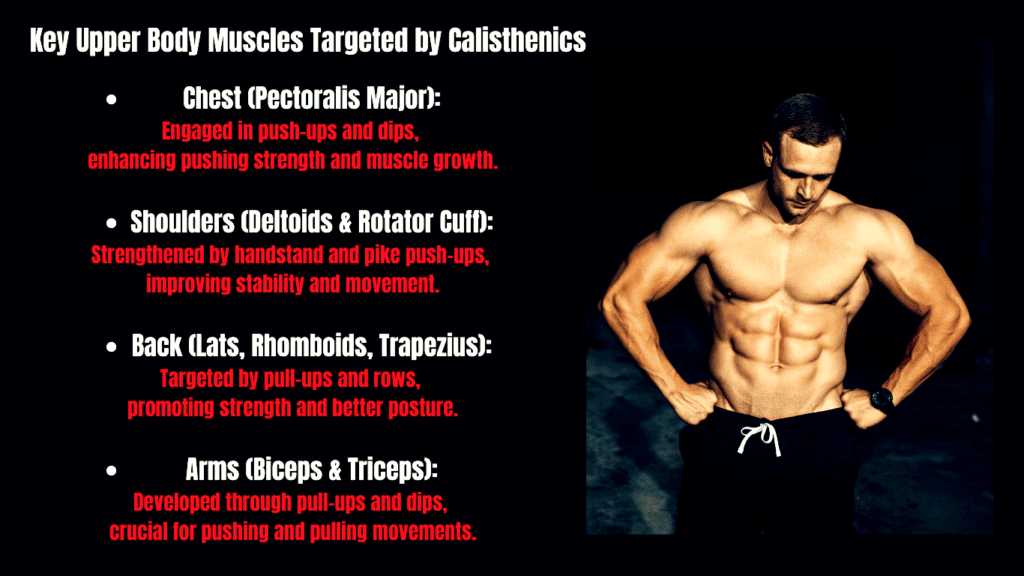
Understanding which muscles are engaged during upper body calisthenics exercises can help you get the most out of your workouts. Let’s break down the major upper body muscles—chest, shoulders, back, and arms—and explore how these exercises work to strengthen them.
Chest Muscles: The primary muscle in your chest is the pectoralis major. It’s responsible for movements like pushing and lifting. During upper body calisthenics exercises such as push-ups and dips, the pectoralis major is heavily engaged. These exercises require you to push your body weight away from the ground or a surface, which activates the chest muscles. As you perform these movements, the pectoralis major contracts to help lift and lower your body, leading to increased strength and muscle growth in the chest area.
Shoulder Muscles: Your shoulders are comprised of several muscles, including the deltoids and the rotator cuff muscles. The deltoids are responsible for lifting your arms and providing a range of shoulder movements. In upper body calisthenics exercises like handstand push-ups and pike push-ups, the deltoids play a significant role. These exercises involve pushing your body upwards or holding positions that require shoulder strength and stability. The rotator cuff muscles also contribute to shoulder stability, which is crucial for performing various calisthenics movements safely and effectively.
Back Muscles: The back is made up of several major muscles, including the latissimus dorsi, rhomboids, and trapezius. The latissimus dorsi, or “lats,” are responsible for pulling movements and help in actions like pulling your arms down and back. Upper body calisthenics exercises such as pull-ups and bodyweight rows target these muscles. When you perform these exercises, you pull your body weight up or towards you, which engages the lats and other back muscles. This helps in developing a strong, defined back and improving posture.
Arm Muscles: The arms consist of the biceps and triceps, which are essential for various pushing and pulling movements. The biceps are responsible for flexing the elbow and lifting movements, while the triceps extend the elbow and assist in pushing actions. Upper body calisthenics exercises like pull-ups, dips, and push-ups target these muscles effectively. For example, during a pull-up, your biceps contract to pull your body up towards the bar, while the triceps assist in stabilizing the movement.
So, how do upper body calisthenics exercises specifically target these muscles? The principle behind these exercises is that they use your body weight as resistance. This means that as you perform the exercises, you are working against the force of gravity, which challenges your muscles and stimulates growth.
Push-Ups are a great example. When you lower yourself towards the ground and then push back up, you’re engaging the chest, shoulders, and triceps. Your core muscles also help stabilize your body during the movement. By varying hand positions and angles, you can target different parts of the chest and shoulders.
Pull-Ups are another effective exercise. As you pull your body up towards a bar, your back muscles (particularly the lats) and arms (biceps) are heavily engaged. The exercise also works the shoulders and core, as they assist in stabilizing your body throughout the movement.
Dips target the chest, shoulders, and triceps. By lowering your body between two parallel bars and then pushing yourself back up, you engage these muscles significantly. Adjusting the lean of your torso can shift the emphasis to different muscle groups.
Planks and their variations are excellent for working the core while also engaging the shoulders and arms. In a plank, you hold a position that requires your body to remain straight and aligned, which strengthens the core and supports upper body strength.
Each of these upper body calisthenics exercises relies on the principle of muscle engagement through body weight resistance. The exercises force your muscles to work together to stabilize and move your body, leading to effective strength building and muscle development.
By incorporating a variety of these exercises into your routine, you can ensure that you’re targeting all major upper body muscles and developing balanced strength. Whether you’re performing push-ups to build chest and tricep strength, pull-ups to enhance your back muscles, or dips to work on your shoulders, each exercise contributes to a well-rounded fitness regimen.
Muscle Engagement in Upper Body Calisthenics Exercises Chart:
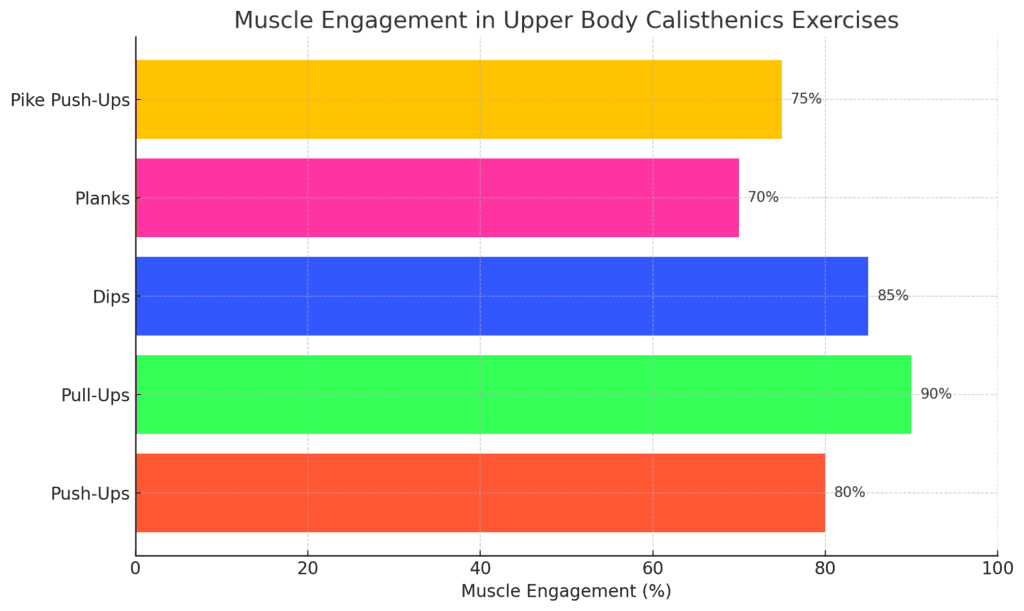
The chart above illustrates the percentage of muscle engagement for several key upper body calisthenics exercises: Push-Ups, Pull-Ups, Dips, Planks, and Pike Push-Ups. Each exercise effectively targets multiple muscle groups, enhancing overall strength and functionality.
- Push-Ups (80%) engage the chest, shoulders, triceps, and core, making them a foundational movement for building upper body strength. Their versatility allows for various modifications to increase difficulty as strength improves.
- Pull-Ups (90%) are exceptional for targeting the back muscles, particularly the latissimus dorsi, as well as the biceps and shoulders. This high level of muscle engagement makes pull-ups one of the most effective exercises for developing upper body strength.
- Dips (85%) primarily work the triceps, chest, and shoulders. This exercise is excellent for building pushing strength and can be modified to focus on different muscle groups by adjusting body position.
- Planks (70%) may seem like a core exercise, but they also engage the shoulders and arms. This exercise emphasizes stability and strength, which are crucial for improving overall functional fitness.
- Pike Push-Ups (75%) specifically target the shoulders while also engaging the chest and triceps. This exercise mimics the motion of a handstand, contributing to shoulder strength and stability.
Why This Matters
Understanding muscle engagement is crucial for optimizing your workouts. By incorporating a variety of these exercises into your routine, you can ensure balanced development across all major upper body muscle groups. This holistic approach not only improves strength and endurance but also enhances performance in daily activities and sports.
As you integrate these exercises, consider your fitness goals and adjust the intensity and variety of movements to continuously challenge your muscles. By doing so, you’ll harness the full benefits of upper body calisthenics, leading to improved strength, endurance, and overall physical fitness.
Understanding the anatomy of the upper body muscles and how upper body calisthenics exercises target these areas can help you make the most of your workouts. By engaging key muscle groups with bodyweight movements, you not only build strength and endurance but also improve functional fitness that translates into everyday activities.
Top Upper Body Calisthenics Exercises
Why did the bodybuilder bring a ladder to the gym? Because he heard the push-ups were going to be “a step up” in his routine! Jokes aside, let’s dive into the practical world of upper body calisthenics exercises and explore some top exercises you can incorporate into your fitness routine. Understanding the correct form, variations, and the science behind these exercises will help you maximize your results and achieve your fitness goals.
Push-Ups
Description: Push-ups are a fundamental exercise in upper body calisthenics exercises. To perform a standard push-up correctly, start by positioning your hands slightly wider than shoulder-width apart on the floor. Your body should form a straight line from your head to your heels. Lower yourself towards the ground by bending your elbows until your chest nearly touches the floor, then push yourself back up to the starting position. It’s crucial to maintain a straight body throughout the movement to avoid unnecessary strain on your lower back.

Variations: To add variety and target different muscle groups, try these push-up variations:
- Incline Push-Ups: Place your hands on an elevated surface, such as a bench. This reduces the amount of body weight you’re lifting, making the exercise slightly easier and shifting more emphasis onto the lower chest.
- Decline Push-Ups: Position your feet on an elevated surface, increasing the challenge and focusing more on the upper chest and shoulders.
- Diamond Push-Ups: Place your hands close together beneath your chest. This variation places greater emphasis on the triceps and inner chest.
Science: Push-ups effectively target the chest, shoulders, and triceps. As you lower your body, your chest muscles (pectoralis major) are engaged to control the movement. Pushing back up involves the triceps (muscles at the back of your arms) and the deltoids (shoulder muscles). This combination of muscle engagement helps in building upper body strength and endurance.
Pull-Ups
Description: Pull-ups are another cornerstone of upper body calisthenics exercises. To perform a pull-up, grasp a horizontal bar with your palms facing away from you (overhand grip) or towards you (underhand grip). Your hands should be slightly wider than shoulder-width apart. Hang from the bar with your arms fully extended, then pull your body upward until your chin is above the bar. Lower yourself back down with control. Avoid swinging or using momentum, as this can reduce the exercise’s effectiveness and increase injury risk.

Challenges: Common challenges with pull-ups include difficulty lifting your body weight or maintaining proper form. Beginners might benefit from using an assisted pull-up machine or resistance bands to build strength gradually. Additionally, focusing on grip strength and practicing negative pull-ups (slowly lowering yourself from the bar) can improve performance.
Science: Pull-ups engage the muscles in your back, including the latissimus dorsi, as well as your biceps. When you pull yourself up, the latissimus dorsi works to bring your elbows down and back, while your biceps assist in flexing the elbows. This comprehensive engagement results in a strong back and well-developed arms.
Dips
Description: Dips are excellent for targeting the chest and triceps. To perform a dip, position yourself between two parallel bars or on a sturdy surface with your hands placed behind you. Lower your body by bending your elbows until your upper arms are parallel to the ground, then push yourself back up to the starting position. Keep your elbows close to your body and lean slightly forward to emphasize the chest muscles; keeping your torso upright focuses more on the triceps.
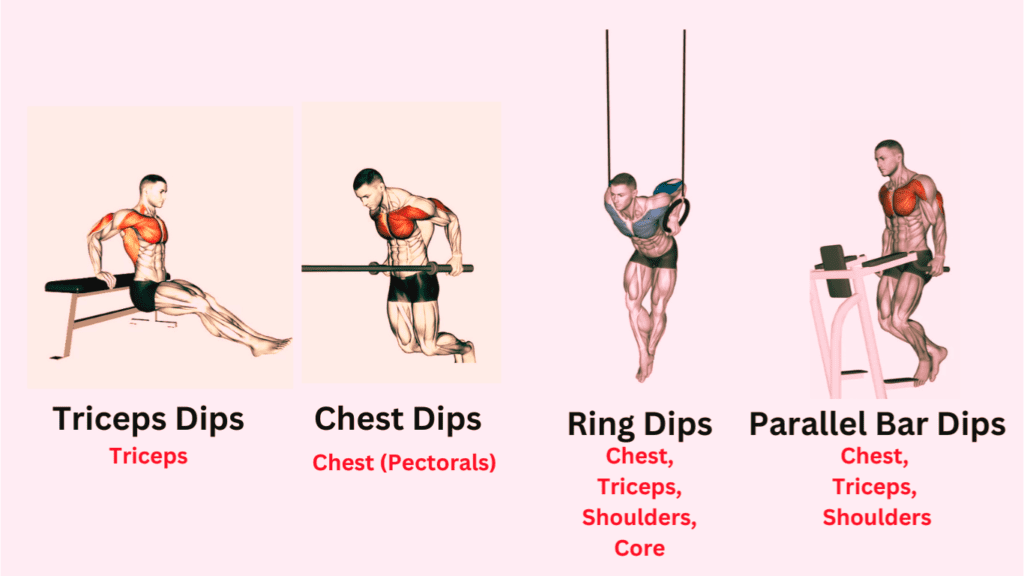
Variations: Different types of dips can help you target specific muscles:
- Bench Dips: Performed with your hands on a bench and your feet on the ground, these are a good alternative if parallel bars are unavailable.
- Knee Dips: Bend your knees and keep your feet on the ground to modify the exercise for beginners.
- Weighted Dips: Using a dip belt or holding a weight can increase the intensity and help build more muscle.
Science: Dips target the chest and triceps effectively. The downward movement engages the chest muscles (pectoralis major), while the upward push activates the triceps. This exercise also works stabilizer muscles around the shoulders, enhancing overall upper body strength and stability.
Planks
Description: Planks are a versatile exercise that engages multiple upper body muscles. To perform a plank, position yourself on the floor with your forearms and toes touching the ground. Your body should form a straight line from your head to your heels. Hold this position, ensuring that your hips do not sag or rise. Maintaining a tight core and aligned body is crucial for maximizing the exercise’s effectiveness.

Variations: To add variety and increase the challenge, try these plank variations:
- Side Plank: Balance on one forearm and the side of your foot to target the oblique muscles and improve core stability.
- Plank to Push-Up: Transition from a plank position to a push-up position to add a dynamic element and increase intensity.
Science: Planks engage the core muscles, including the rectus abdominis, obliques, and transverse abdominis. They also strengthen the shoulders, chest, and back as they work to stabilize the body. This comprehensive engagement improves overall core strength and stability, which benefits athletic performance and daily activities.
Bodyweight Rows
Description: Bodyweight rows are an effective exercise in upper body calisthenics exercises that targets the back and biceps. To perform a bodyweight row, set up a bar at waist height or use a suspension trainer. Hang underneath the bar with your body straight and your heels on the ground. Grasp the bar with an overhand grip, and pull your chest towards the bar by bending your elbows and retracting your shoulder blades. Lower yourself back to the starting position with control.

Variations:
- Inverted Rows: Performed with your feet elevated, this increases the challenge and engages the upper back more intensely.
- Wide-Grip Rows: By widening your grip on the bar, you emphasize the upper back muscles and rear deltoids.
Science: Bodyweight rows engage the latissimus dorsi, rhomboids, and biceps. Pulling your chest towards the bar activates these muscles, improving upper back strength and posture.
Archer Push-Ups
Description: Archer push-ups are an advanced variation of push-ups that targets one side of the chest more intensively. To perform an archer push-up, get into a push-up position and extend one arm out to the side while keeping the other arm bent. Lower yourself towards the bent arm, then push back up. Alternate sides after each set.
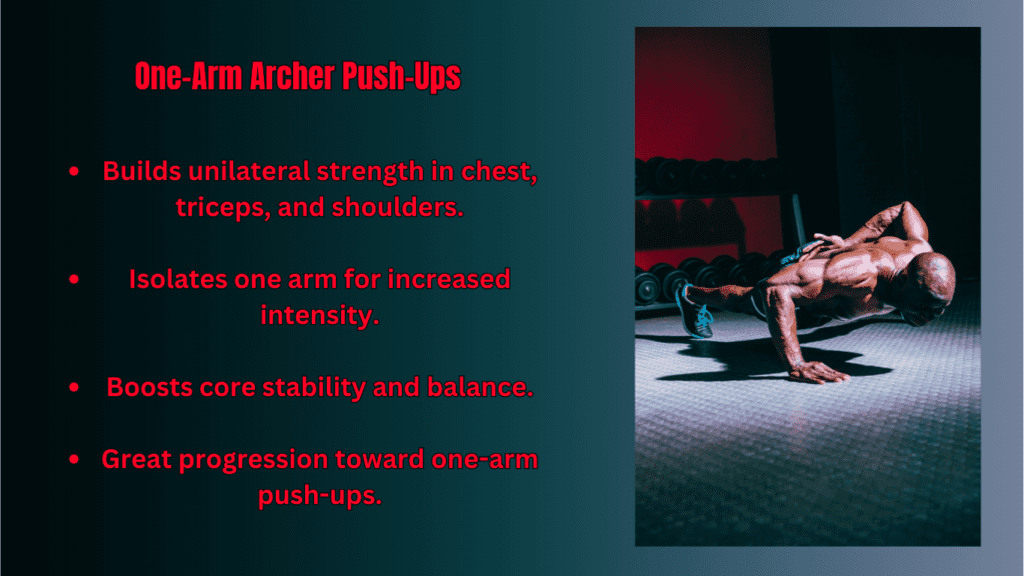
Variations:
- One-Arm Archer Push-Ups: For an even greater challenge, perform the exercise with one arm while keeping the other arm extended.
Science: Archer push-ups engage the chest, triceps, and shoulders more deeply by shifting more weight to one side of the body. This helps in building unilateral strength and muscular balance.
Handstand Push-Ups
Description: Handstand push-ups are an advanced exercise in upper body calisthenics exercises that focuses on shoulder strength and stability. To perform a handstand push-up, kick up into a handstand against a wall for support. Lower your head towards the ground by bending your elbows, then push back up to the starting position.
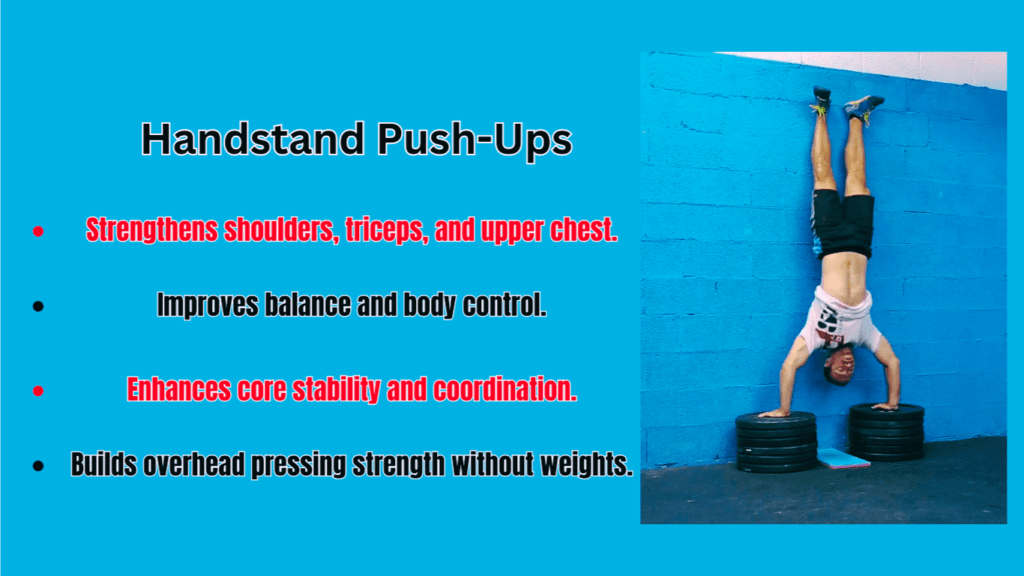
Variations:
- Wall-Supported Handstand Push-Ups: Great for beginners, as the wall provides balance and support.
- Freestanding Handstand Push-Ups: For advanced practitioners looking to increase balance and strength.
Science: Handstand push-ups target the shoulders (deltoids) and triceps, while also engaging the core for stabilization. The vertical position increases the demand on shoulder strength and control.
Chart: Comparative Analysis of Top Upper Body Calisthenics Exercises
| Exercise | Primary Target Muscles | Muscle Engagement (%) | Difficulty Level | Benefits |
|---|---|---|---|---|
| Push-Ups | Chest, Shoulders, Triceps | 80% | Intermediate | Builds foundational strength, enhances endurance |
| Pull-Ups | Back, Biceps | 90% | Advanced | Develops upper back strength, improves grip strength |
| Dips | Chest, Triceps | 85% | Intermediate | Increases pushing strength, enhances shoulder stability |
| Planks | Core, Shoulders, Back | 70% | Beginner | Improves core stability, supports posture |
| Bodyweight Rows | Back, Biceps | 85% | Intermediate | Strengthens upper back, improves posture |
| Archer Push-Ups | Chest, Triceps, Shoulders | 85% | Advanced | Builds unilateral strength, improves muscle balance |
| Handstand Push-Ups | Shoulders, Triceps | 90% | Advanced | Increases shoulder strength, improves balance |
Explanation of the Chart
The chart above provides a detailed comparative analysis of some of the top upper body calisthenics exercises mentioned in the article. Here is a detailed explanation:
- Muscle Engagement: Each exercise’s muscle engagement percentage highlights the intensity and effectiveness of the workout. For instance, Pull-Ups and Handstand Push-Ups engage a high percentage of muscle fibers (90%), making them powerful movements for building strength in the back and shoulders.
- Difficulty Level: The chart categorizes each exercise by difficulty level—Beginner, Intermediate, and Advanced. This helps readers gauge which exercises are suitable for their current fitness level, making it easier to create a personalized workout routine.
- Benefits: The benefits column succinctly summarizes what each exercise contributes to overall fitness. For example, Dips not only target the chest and triceps but also enhance shoulder stability, making them a great addition for athletes.
Upper body calisthenics exercises like push-ups, pull-ups, dips, planks, bodyweight rows, archer push-ups, and handstand push-ups offer a diverse range of movements that target various muscle groups. Understanding how to perform these exercises correctly, exploring their variations, and appreciating the science behind them can help you achieve a well-rounded and effective workout. Incorporate these exercises into your routine to build a strong, balanced upper body and support your overall fitness goals.
Creating a Balanced Workout Routine
Did you know that the military often incorporates calisthenics into their training because it builds strength and endurance without needing a gym? It’s no surprise, then, that upper body calisthenics exercises have become a staple in many fitness routines. Designing a balanced workout routine using these exercises can be highly effective in improving overall strength and fitness. Let’s explore how to create a personalized calisthenics routine, look at sample workouts for different skill levels, and learn how to progress and avoid common mistakes.
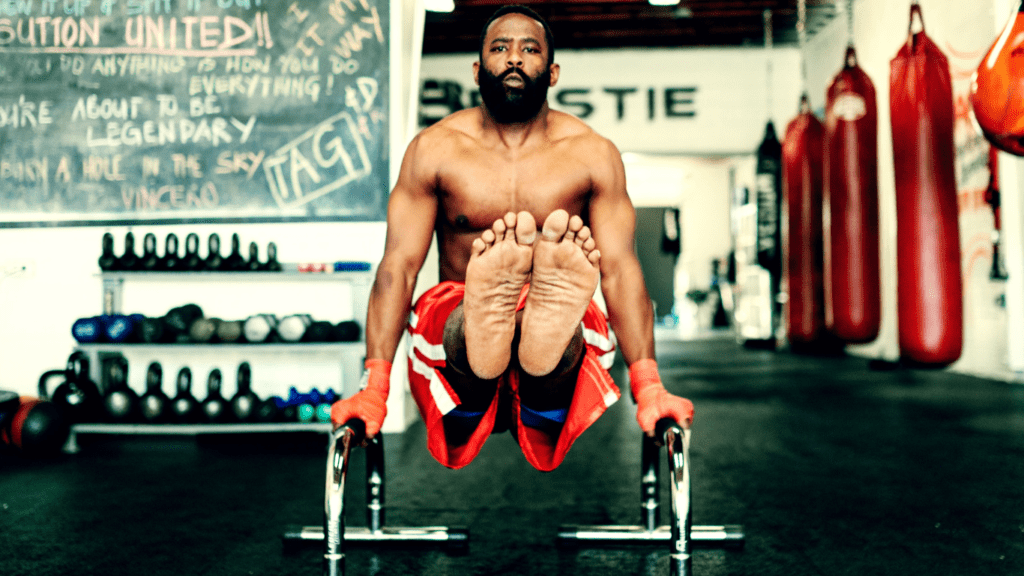
Creating a Balanced Workout Routine
Planning Your Routine: When creating a workout routine based on upper body calisthenics exercises, it’s crucial to start with a clear plan. Consider these key components:
- Goals: Define what you want to achieve—whether it’s muscle growth, increased endurance, or overall fitness.
- Frequency: Determine how many days per week you’ll dedicate to your calisthenics workouts. For most people, 3 to 4 days per week is ideal.
- Warm-Up and Cool-Down: Incorporate a proper warm-up to prepare your muscles and joints for exercise, and a cool-down to aid recovery.
Structuring Your Routine: A balanced calisthenics workout should target all major upper body muscle groups. Ensure your routine includes exercises that focus on:
- Push Movements: For chest and triceps (e.g., push-ups, dips).
- Pull Movements: For back and biceps (e.g., pull-ups, bodyweight rows).
- Core Stability: For overall strength and stability (e.g., planks, handstand push-ups).
Sample Routine
Beginner Routine:
- Push-Ups: 3 sets of 10-12 reps
- Bodyweight Rows: 3 sets of 8-10 reps
- Bench Dips: 3 sets of 8-10 reps
- Planks: 3 sets of 20-30 seconds
Intermediate Routine:
- Incline Push-Ups: 3 sets of 12-15 reps
- Pull-Ups (Assisted if needed): 3 sets of 6-8 reps
- Knee Dips: 3 sets of 10-12 reps
- Side Planks: 3 sets of 20-30 seconds per side
Advanced Routine:
- Decline Push-Ups: 4 sets of 15-20 reps
- Unassisted Pull-Ups: 4 sets of 10-12 reps
- Weighted Dips: 4 sets of 8-10 reps
- Handstand Push-Ups: 4 sets of 5-8 reps
Tips for Progression
Increasing Reps: Gradually increase the number of repetitions or sets as you get stronger. For instance, if you can comfortably perform 12 push-ups, aim for 15 in your next workout.
Adjusting Difficulty: To continue challenging yourself, adjust the difficulty of exercises. For example, progress from regular push-ups to decline push-ups or from assisted pull-ups to unassisted ones.
Incorporating Rest: Rest is essential for muscle recovery and growth. Ensure you have adequate rest days between workouts and listen to your body to avoid overtraining.
Common Mistakes
Improper Form: One of the most common mistakes in upper body calisthenics exercises is performing exercises with poor form. This can lead to injuries and reduced effectiveness. Focus on mastering proper technique before increasing intensity.
Neglecting Rest: Skipping rest days or not allowing enough recovery time can hinder progress and increase the risk of injury. Ensure you give your muscles time to recover between sessions.
Overtraining: Another mistake is overtraining, which can occur if you do too much too soon. Gradually increase the volume and intensity of your workouts to avoid burnout and injury.
Skipping Warm-Up and Cool-Down: Failing to warm up before exercising or cool down afterward can lead to muscle strains and hinder recovery. Always include a warm-up to prepare your body and a cool-down to aid recovery.
Creating a balanced workout routine with upper body calisthenics exercises involves careful planning, consistent practice, and attention to detail. By incorporating a variety of exercises, progressively challenging yourself, and avoiding common pitfalls, you can develop a strong, well-rounded upper body. Whether you’re a beginner or an advanced practitioner, these guidelines and sample routines will help you effectively build strength and achieve your fitness goals.
Science Behind Upper Body Calisthenics Exercises: Recovery and Injury Prevention
Here’s an intriguing fact: The human body has over 600 muscles, and with just bodyweight exercises like upper body calisthenics exercises, you can engage a significant portion of them effectively. This highlights the incredible efficiency of calisthenics in building strength and functionality. But to truly optimize your performance and recovery in calisthenics, integrating scientific principles into your training is crucial. Let’s explore how recovery, nutrition, and injury prevention play essential roles in your fitness journey.
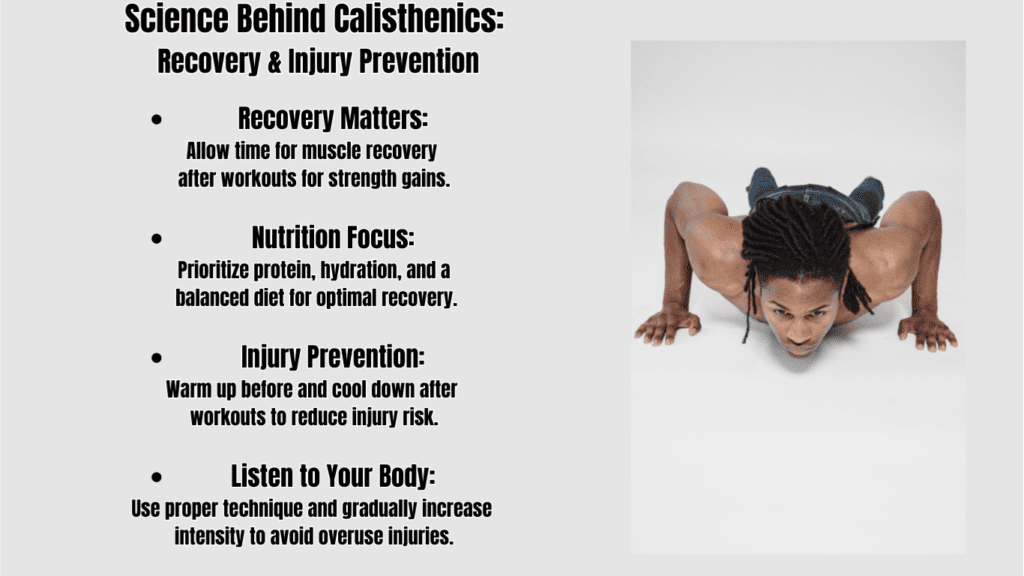
Recovery and Nutrition
Importance of Recovery: Recovery is a vital component of any fitness regimen, including upper body calisthenics exercises. When you perform these exercises, you create tiny tears in your muscle fibers. This is a normal part of the muscle-building process, but it’s during the recovery phase that these fibers repair and grow stronger. Without adequate recovery, you may experience diminished performance, increased fatigue, or even injury.
To support effective recovery, prioritize:
- Rest Days: Ensure you have scheduled rest days in your routine to allow muscles to repair. For beginners, 1-2 rest days between workouts can be beneficial, while advanced practitioners may need more frequent rest periods.
- Sleep: Aim for 7-9 hours of quality sleep each night. Sleep is crucial for muscle recovery and overall health.
Nutrition for Optimal Performance: Proper nutrition supports muscle recovery and overall performance. Focus on these key dietary aspects:
- Protein Intake: Protein is essential for muscle repair and growth. Aim for a balanced intake of protein from sources like lean meats, fish, eggs, beans, and legumes. A general guideline is to consume about 1.2 to 2.0 grams of protein per kilogram of body weight, depending on your activity level and goals.
- Hydration: Staying hydrated is important for muscle function and recovery. Drink plenty of water throughout the day, and consider electrolyte-rich beverages if you’re engaging in intense workouts.
- Balanced Diet: Alongside protein, ensure you’re consuming a variety of nutrients, including carbohydrates for energy and fats for overall health. A well-rounded diet will support your training and recovery processes.
Injury Prevention
Proper Warm-Up and Cool-Down: One of the most effective ways to prevent injuries during upper body calisthenics exercises is through proper warm-up and cool-down routines.
- Warm-Up: A good warm-up prepares your muscles and joints for the workout ahead. It increases blood flow to your muscles, enhances flexibility, and reduces the risk of strains. Incorporate dynamic stretches and light cardio exercises, such as arm circles, jumping jacks, or brisk walking, before starting your workout.
- Cool-Down: Cooling down after your workout helps to lower your heart rate gradually and promotes muscle relaxation. Incorporate static stretching, focusing on the muscles you worked during your session. This can help prevent stiffness and improve flexibility.
Listening to Your Body: Pay attention to your body’s signals to prevent overuse injuries. If you experience persistent pain or discomfort, it’s important to address it promptly. Adjust your workout intensity, take additional rest, or consult a healthcare professional if needed.
Proper Technique: Using the correct form for each exercise is crucial in preventing injuries. Whether you’re doing push-ups, pull-ups, or dips, ensure that you’re performing each movement with proper alignment and technique. Incorrect form can lead to unnecessary strain on muscles and joints.
Gradual Progression: Avoid the temptation to jump into advanced upper body calisthenics exercises too quickly. Gradually increase the intensity and volume of your workouts to allow your body to adapt and build strength over time. Rapid increases in difficulty can lead to overtraining and injuries.
Balancing Workouts: Ensure your routine is well-balanced and doesn’t overemphasize one muscle group while neglecting others. This balance helps in preventing muscular imbalances and reduces the risk of overuse injuries.
Integrating science into your upper body calisthenics exercises regimen is crucial for optimizing performance and preventing injuries. By focusing on proper recovery, nutrition, and injury prevention strategies, you can enhance your strength, endurance, and overall fitness while minimizing the risk of setbacks. Remember, effective training goes beyond just performing exercises—it involves a holistic approach to health and well-being.
Achieving Success with Upper Body Calisthenics Exercises
Did you hear about the guy who tried to impress everyone with his calisthenics skills at the beach, only to be mistaken for a malfunctioning robot? It turns out, even the most impressive upper body calisthenics exercises can sometimes look a bit awkward when you’re just starting out!
But here’s the serious side of it: According to a study by the American Council on Exercise, calisthenics workouts not only enhance strength but also improve coordination and body control. It’s a testament to how effective bodyweight training can be, even if it doesn’t always look graceful!
Now, let’s dive into why incorporating upper body calisthenics exercises into your routine can be a game-changer for your fitness journey.
Mastering the Basics: You’ve learned that these exercises are powerful tools for building strength and endurance. They use your own body weight to challenge your muscles, improve stability, and enhance functional fitness. The beauty of upper body calisthenics exercises lies in their simplicity and effectiveness. By focusing on foundational movements like push-ups, pull-ups, and dips, you can achieve remarkable results without needing fancy equipment.

Building a Strong Foundation: Understanding the science behind these exercises helps you appreciate their effectiveness. These movements engage multiple muscle groups simultaneously, promoting balanced muscle development and improving overall strength. Whether you’re doing a standard push-up or an advanced variation, you’re effectively targeting your chest, shoulders, back, and arms—all essential components for upper body strength.
Creating a Balanced Routine: Structuring a workout routine that includes a variety of bodyweight exercises ensures comprehensive muscle engagement and balanced development. The sample routines we discussed provide a clear path for beginners, intermediates, and advanced practitioners. Each stage of progression is designed to help you build strength gradually while avoiding plateaus.
Optimizing Recovery and Nutrition: Remember, achieving your fitness goals with upper body calisthenics exercises isn’t just about the workout itself. Proper recovery and nutrition play crucial roles in your progress. Incorporate adequate rest, prioritize protein intake, and stay hydrated to support muscle repair and growth. By paying attention to these aspects, you’ll maximize the benefits of your workouts and maintain a steady progression.
Preventing Injuries: Avoiding common pitfalls like poor form or overtraining is essential for long-term success. Implementing effective warm-up and cool-down routines, listening to your body, and gradually increasing exercise intensity will help prevent injuries and keep you on track. The goal is to challenge yourself while ensuring that you stay safe and healthy throughout your fitness journey.
Embracing the Challenge: Now, here’s where the motivation comes in. Starting a new fitness routine might feel intimidating, but every journey begins with a single step. Embrace the challenge of upper body calisthenics exercises with enthusiasm and determination. The progress you make, the strength you build, and the confidence you gain will be incredibly rewarding.
Think about the satisfaction of mastering a new exercise or achieving a personal best. That sense of accomplishment fuels your motivation and makes the hard work worthwhile. Each workout is a step closer to your goals, and every effort you put in brings you that much closer to the results you want.
Get Started Today: So, what are you waiting for? Dive into the world of calisthenics and experience the benefits for yourself. Whether you’re aiming to build strength, improve endurance, or simply enjoy a more active lifestyle, upper body calisthenics exercises offer a practical and effective solution. Start today, stay committed, and watch as your hard work transforms into real results.
We’d love to hear about your experiences and progress. Share your stories, challenges, and victories in the comments below. Your journey can inspire others to take their first step towards fitness. And don’t forget to follow us for more tips and motivation to keep you moving forward.
Integrating upper body calisthenics exercises into your routine can lead to incredible improvements in strength and overall fitness. Embrace the process, stay motivated, and keep pushing towards your goals. The journey might have its challenges, but the rewards are well worth the effort. Let’s get started and make every rep count!


